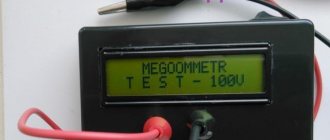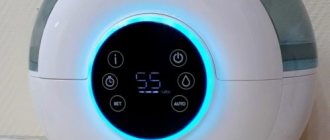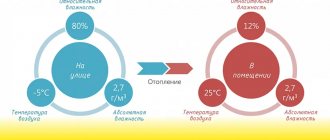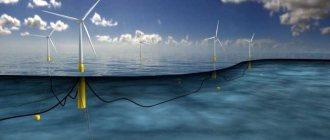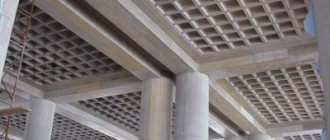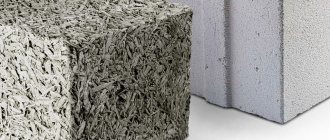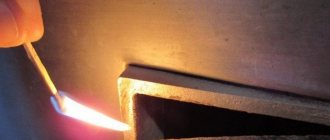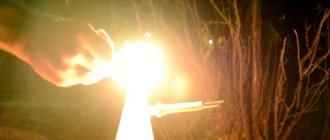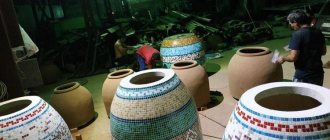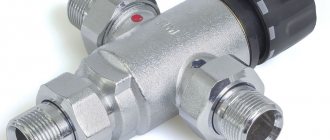Wood is an environmentally friendly material, in demand in the construction of various types of objects, at all stages of construction and installation work, as well as in the manufacture of furniture and interior items.
To determine the quality of wood, there are special instruments and devices that facilitate the implementation of work on incoming control of raw materials and compliance with production technologies for products and blanks made from wood.
Moisture meters for wood - types and descriptions of popular models, how to choose, as well as an overview of prices for the most popular models, this is the topic of this article.
Using the meter, you can almost instantly determine the percentage of moisture content in a wooden product or the raw materials used
Why do you need to measure air humidity?
Both excessively dry and excessively humid air can lead to incorrect operation of various devices and equipment and cause health problems. There are optimal humidity parameters for the growth of plants and animals, as well as fermentation processes, which play an important role in food production.
High humidity can cause mold, mildew, and damage to furniture, things and food in the room. Excessive dryness causes a lot of dermatological problems, often causes allergies and causes asthma in a person.
Air is considered too dry when its moisture vapor content is less than 40%, and excessively humid when it contains more than 80%.
Choosing a moisture meter for wood
Hello dear readers and subscribers of the blog, Andrey Noak is in touch with you! Today I will tell you how to choose a moisture meter for wood. What will be in the article today is purely my personal experience of working as a foreman in a molded products workshop, a foreman of drying chambers and a chief technologist in a large and modern woodworking production.
Instruments for measuring air humidity: types, operating principle
Modern manufacturers produce devices of various types and types. The oldest measuring device is the moisture meter, invented by Leonardo da Vinci in 1400. Now it is practically not used.
Modern moisture meters are called hygrometers
It was a pharmacy scale, on one bowl of which a piece of wax was placed, and on the other the same amount of some porous material. The disadvantage of the device is that it can only be used to control fluctuations in air humidity.
Expert opinion
Chebatkov Maxim Pavlovich
Specialist in household appliances and their repair
Modern moisture meters are called hygrometers. These are more accurate measuring devices. Manufacturers produce a wide range of these products, which have different operating principles. All of them serve to measure relative air humidity and have varying degrees of error.
Hygrometers are distinguished:
- Hairy . Their operating principle is based on changing the length of human hair, which is the main element of the device. In dry rooms, hair shortens, and in humid rooms it lengthens. These fluctuations in hair length are displayed on the device scale as an indicator of the percentage of moisture vapor in the air.
- Psychometric . Their design is considered the simplest. It consists of two mercury thermometers. One of them is dry, and the second is wet. The humidity indicator is determined from the table from the difference in the readings of the thermometers of the device. The work of the psychometer is based on the principle of evaporation and absorption of water. When liquid evaporates from the wetted surface of one of the thermometers, energy loss occurs and, as a result, temperature drops. The reverse process causes an increase in air humidity in the room.
- Weighing . The device consists of a pump and tubes filled with a hygroscopic composition that can absorb air. Using a pump, air is pumped into the device, the volume of which and the weight of the structure determine the relative humidity of the air.
- Mechanical (ceramic) . The operating principle of the device is based on measuring the electrical resistance of the device filler. It changes with fluctuations in relative air humidity. The filler is a ceramic mass consisting of oxides of kaolin, silicon and clay.
- Electronic . The most accurate device. The operating principle is based on changing the resistance of lithium chloride, which is applied to a special glass plate.
- Condensation . The main element of the device is a mirror, the temperature of which changes along with fluctuations in air humidity.
Instrument measurement data can be displayed on displays in numerical format or on a dial with an arrow.
Overview of species
Currently, you can find several types of hygrometers (depending on the method for determining the level of water content in the material).
- Conductivity meter. Measures electrical conductivity and calculates the degree of humidity based on deviation from the standard.
- Dielmeter. Measures the dielectric constant and, based on the difference with the reference value, determines the water content.
- Infrared and microwave meters. In the first case, the degree of reflection of infrared rays is determined, in the second, the degree of absorption of high-frequency radiation. These types of hygrometers cannot be classified as compact products - they are installed permanently at large woodworking enterprises.
Needle-shaped
Another name for conductometers is needle moisture meters. They got it from two electrode needles that are dipped into wood to measure the current between them. The length of the needles can vary from 1.5 to 2.5 cm, the distance between them depends entirely on the manufacturer.
Contactless
Dielcometric or non-contact (induction) hygrometers work on a different principle - the test sample is placed in an artificially created EM field. This generates a high frequency electric current. Its strength depends on the humidity of the environment in which it is formed.
Stadler Form Selina Little Hygrometer White S-080
Stadler Form Selina Little Hygrometer White S-080
Country of origin: Switzerland. Very light model. Its weight is only 15 grams. The small overall dimensions of the device allow it to be carried in a clothing pocket. Using this model, you can measure not only relative air humidity, but also temperature. The latter indicator can be displayed on the screen in C° or F°.
The measurement error is +3%. The device has a convenient retractable stand and a large screen. If necessary, it can be mounted to a wall or cabinet. The range of measurement of air humidity is 10-98%, temperature – from -10 to +50 C°. The manufacturer's warranty period is 12 months.
Advantages:
- portability;
- light weight;
- clear display of measurement results;
- ease of installation and measurement.
No deficiencies found.
Devices for building materials
These devices are designed for measuring moisture in plaster, drywall, concrete and brick. Inies are light in weight, compact in size and have low accuracy.
Megeon 20550
The device will quickly determine the moisture content of building materials. It has high functionality. The device can measure not only humidity, but also temperature, as well as the mass of individual bulk materials. The kit includes a measuring cup, with which it is convenient to carry out analysis. The device is equipped with the option of adjusting the taken indicators. Humidity is measured in the range from 3 to 35%. Users have no complaints about the operation of the device. It is inferior in characteristics only to the winner of the rating.
Megeon 20550
Advantages:
- the presence of a large number of additional options;
- The set includes a measuring cup;
- data can be corrected;
- The small monitor is backlit.
Flaws:
- small humidity measurement range;
- high cost.
Testo 606-2 16
The price of the device is 9,000 rubles. It has the functions of a moisture meter, thermometer and hygrometer. Using the device, you can measure the humidity and temperature of brick, concrete, and screed. The device will also determine the moisture content in the air. The device body is reliably protected from moisture penetration. It can be used both at home and outdoors. Users note the high reliability of the device, long service life and low error. Light weight and small dimensions make the device convenient to use. Buyers cite only the high price as a disadvantage.
Testo 606-2 16
Advantages:
- high functionality;
- the body is not afraid of moisture penetration;
- low error;
- long service life.
Flaws:
- high price.
Control Hydro Pro new
This device can be found in stores for 11,050 rubles. The product is intended for measuring the moisture content in concrete. The specialization is quite narrow. However, the high price is compensated by the high accuracy of the readings taken and the availability of additional options. The advantage of the device is the ability to take measurements without contact. The manufacturer has developed an external sensor, which is located at the measurement location. Humidity is measured in the range from 1 to 35%. This is a good indicator. One set of batteries lasts for a long period.
Control Hydro Pro new
Advantages:
- low error;
- availability of a large number of options;
- measurements are carried out using a non-contact method;
- long service life;
- low electricity consumption.
Flaws:
- too much cost.
Megeon 20207
Megeon 20207
Country of origin: China. The electronic hygrometer has a wide LCD screen that is easy to visualize, on which all measurement indicators are simultaneously displayed. With this model you can measure relative humidity and temperature. There is a memory for storing previous measurements.
The model has a push-button control device, small size and light weight. The design is equipped with an alarm clock, clock and calendar. The model is intended for taking measurements at home and in office premises. Powered by AAA battery. Operating voltage 1.5 V. The device can operate in the temperature range from -50 to +70°C. This allows it to be used in unheated buildings. Measurement error +5%.
Advantages:
- compactness and light weight;
- economical power consumption;
- ease of operation;
- heat resistance.
Main disadvantage:
- high percentage of error.
How to use it correctly?
Despite the fact that these devices always come with instructions for proper use, some people cannot always correctly interpret the information described in the instructions for use. Now we will explain everything clearly to you.
Let's say you need to determine the moisture level of a parquet board. In this example, it is better to use a non-contact model; it will not harm the finished product. So, the measurement process goes like this:
- The board itself is prepared (cleaned of debris, it is advisable to ensure a flat surface).
- The device turns on (the button on the device itself).
- The calibration is set (according to the table in the instructions).
- The moisture meter is brought with the sensor side to the surface of the board or inserted into it.
- The display shows the measurement results we need.
CEM DT-322
CEM DT-322
Country of origin: China. The model is intended for measuring relative air humidity and temperature in domestic and office premises. Measurement range: temperature - from 0 to 50°C, humidity - from 10 to 90%. The design has a built-in alarm clock and calendar. Temperature can be measured by the device in C° or F°. Model weight 74 grams. The latest readings from the device are stored in its memory. Measurement error +5%.
Advantages:
- compactness;
- ease of operation;
- maintaining measurement statistics;
- convenient screen and controls.
Main disadvantage:
- Slow sensor operation.
Laserliner ClimaCheck 082.028A
Laserliner ClimaCheck 082.028A
The German brand is made in China. The electronic device is designed to measure temperature and relative humidity in domestic and office premises. The model is equipped with a convenient digital display. Temperature can be measured in C° or F°. The design has a convenient magnetic fastening. The humidity measurement range is from 20 to 99%. Measurement error +1%. The weight of the device is 180 grams.
Advantages:
- ease of operation;
- compactness and light weight;
- multifunctionality.
Main disadvantage:
- inconvenient narrow screen.
general information
Without knowing what types of moisture meters the industry produces, it is impossible to make the optimal choice. The fact is that the devices differ in their operating principle, but in fact they have to work with different workpieces. Wood is a general concept. This category of building materials includes logs, timber, boards, plywood, and so on. It will not be possible to determine humidity with the same moisture meter in all samples without exception. In principle, everything is possible, but in some cases the error will be such that the data from the measurement results will tell us absolutely nothing.
If you have to work with wood constantly, with its various species and preparations, then it is worth purchasing at least a couple of different types of moisture meters. It will be cheaper than one universal one, but at a high price.
G337
G337
Country of origin: China. An alcohol hygrometer can measure temperature and relative humidity indoors and outdoors. Measurement range: temperature – from -40 to +50 C°, humidity – from 0 to 100%. The device body is equipped with a loop for wall mounting and is made of plastic. Model weight 50 grams.
Advantages:
- safety;
- does not require batteries or battery recharging;
- versatility of use;
- light weight.
Main disadvantage:
- outdated design.
What to look for when choosing
Let's consider what criteria should be taken into account in order to make a successful purchase.
- When choosing a moisture meter, the main criterion is the type of unit. There are two types: contact and non-contact.
- Contact (needle). Equipped with small metal needles, which must be immersed in specially prepared holes in the product. After this, the device will begin to create electrical resistance between the needles and the material. Working with this type is quite simple, but the product being tested suffers.
- Non-contact (dielcometric). Created on the basis of a radio frequency generator, which allows you to get a fairly accurate result. The device does not affect the quality of the product being tested.
- Cost of the device. Don't buy an overly expensive model. Their work follows the same principle, which means it makes no sense to overpay for a model whose manufacturers are simply luring buyers.
- Size. The comfort of use depends on the size of the device. Pay attention to the medium-sized model so that it fits easily in your hand. Otherwise, what is the use of a device if it cannot be used?
Boneco A7057
Boneco A7057
Country of origin: Germany. The mechanical hygrometer is designed to measure relative air humidity in domestic and office premises. The model has a white plastic body. The device can be attached to the wall using a sticky element. Measurement readings are displayed on a scale having a measurement range from 20 to 100%. Measurement error +5%.
Advantages:
- compactness;
- nice design;
- low cost.
Flaws:
- the device requires calibration before starting work;
- short warranty period.
Purpose and types of moisture meters
Standard methods for identifying the mass fraction of water in wood raw materials are based on determining the weight of the sample before and after drying when it reaches a constant weight. The procedure is carried out in several stages and requires careful execution and a long time.
In practice, there is often a need to quickly determine the moisture content of raw materials or wood products, which can be done using special compact meters.
There are several types of devices that differ in operating principles. Definitions could be as follows:
- optical;
- radiometric;
- inductive;
- infrared;
- ultra-high frequency;
- combined action.
The devices differ in the accuracy of measurements, the range of concentrations to be recorded, and the type of impact on wood.
VIT-2
VIT-2
Country of origin: Russia. The psychometric type hygrometer is designed for measuring temperature and relative humidity in domestic, office and warehouse premises. The body of the model is made of plastic and has a mount for hanging on the wall. The instrument readings are displayed on a metal scale. Relative humidity measurement range from 20 to 90%.
Dignity:
- low cost;
- simplicity of design.
Main disadvantage:
- the need to periodically add distilled water to the device.
Challenges for measurers
In addition to different raw materials, these devices also perform different tasks, let's look at the most common tasks:
- Quick approximate moisture check on boards without mechanical damage to the material;
- Qualitative inspection of lumber;
- Continuous monitoring of the drying process in drying chambers;
- Inspection of hot lumber;
- Quickly check the water content of hot and cold chips;
- Flow control of hot chips;
- In-line precise control of cooled chips.
And this is not the full range of products and tasks that measurers face. That is why there are so many different types of moisture meters and modifications. I propose now to consider all types of moisture meters and the tasks that each type performs.
TFA 45.2033
TFA 45.2033
Country of origin: Germany. The mechanical type hygrometer is made in the shape of a circle. The case has a brass ring and an informative dial, which is divided into comfort zones. Measuring range: humidity from 0 to 100%, temperature from -15 to +55C°. The device has a wall mount.
Advantages:
- low cost;
- ease of operation;
- wall mounting option.
Main disadvantage:
- When direct sunlight hits the device, it gives readings with a large error.
Price for moisture meters:
You can find out the price and how to buy humidity measuring instruments (moisture meters for wood, concrete and other moisture meters) by filling out a simple online application form or by phone
+7
You can get detailed information on the website: or by calling
We suggest that you familiarize yourself with the following sections:
Moisture meter for builders
Needle moisture meters
Merlin thermohygrometers
Sawo 115-HA
Sawo 115-HA
The Finnish brand is made in the Philippines. The body of the model is made of aspen and has the shape of a house. The original design of the device allows it to be used as an element of interior decor. Measurement readings are displayed on a large graphic dial. The model can be used to control the relative humidity in a steam room. At high temperatures, the hygrometer body begins to emit a pleasant woody aroma. The humidity measurement range of the device is from 0 to 100%.
Advantages:
- low cost;
- high accuracy;
- ease of operation;
- Possibility of use in rooms with high humidity and temperature.
Flaws:
- there is no protective glass on the dial;
- no temperature measurement function.
Moisture meters for building materials
Concrete moisture meters of the EVO series, the operating principle of which is based on the dielcometric measurement method, are compact and easy-to-use devices for measuring the moisture content of concrete and bulk materials of various densities. It is enough to place the moisture meter on the concrete surface, press the button and the information will be displayed on the display. Radio frequency radiation penetrates the thickness of concrete to a depth of 30 mm. It is on the basis of changes in pulse fluctuations that the humidity meter measures humidity. Concrete moisture meters, like wood moisture meters, operate on AA batteries. Humidity measurements can be carried out continuously or at specific time intervals.
The non-destructive testing method and ease of use make these moisture meters indispensable in woodworking and construction organizations.
Harvia SAC92200
Harvia SAC92200
Country of origin: Finland. The body of the model is made of wood in eco-style. It has the shape of a rounded square, into which a clear dial is inserted, the measurement step of which is 10 units. The body material is birch. The model has a hair operating principle. Measuring range: pressure from 0 to 100%, temperature - from -15 to +55C° .
Advantages:
- nice design;
- low cost;
- high accuracy;
- ease of operation.
Main disadvantage:
- long period of response to changes in air humidity.
We study the tool: moisture meters for wood and the nuances of their use
Wood is an environmentally friendly material, in demand in the construction of various types of objects, at all stages of construction and installation work, as well as in the manufacture of furniture and interior items. To determine the quality of wood, there are special instruments and devices that facilitate the implementation of work on incoming control of raw materials and compliance with production technologies for products and blanks made from wood. Moisture meters for wood - types and descriptions of popular models, how to choose, as well as an overview of prices for the most popular models, this is the topic of this article.
Question answer
Should household hygrometers be certified by metrological services?
Household hygrometers do not require such certification, because devices for such purposes are not subject to requirements for high accuracy of readings.
What error indicator can be considered optimal for household appliances that measure relative air humidity?
The maximum permissible error for household appliances is 3-4%.
How long should measurements be taken to obtain a more accurate measurement result?
Household appliances measure relative air humidity within 40-60 seconds. The measurement speed of professional devices is 1-5 seconds.
Can household hygrometers be used to determine relative air humidity and be used to measure the moisture content of bulk materials?
To determine the moisture content of raw materials, manufacturers produce contact devices that have a narrow specialization: for wood, bulk materials, etc.
What measurement range should household hygrometers have?
It all depends on the intended installation location of the device. The range of measurement of relative air humidity should be: for the bathroom and kitchen from 0 to 100%, for living rooms and corridors from 20 to 80%.
Controlling relative air humidity allows you to create comfortable living conditions in residential and working conditions in office spaces. For these purposes, household, non-contact hygrometers are used.
Recommendations for selection
Moisture meters come in different types. After all, you have to measure the level of humidity in materials such as plaster, air, wood, brick, drywall, grain crops and many others. Depending on the design and device, they are divided into the following types:
- Needle instruments (conductometric). Moisture meters are equipped with short, thin electrodes. To measure, they are immersed in the material being studied. The advantage is low weight and compact size. The device has high accuracy. However, it can only be used at positive temperatures. Most often the product is used in the woodworking industry.
- Deep devices are large. They are equipped with a needle probe. It penetrates the wood texture and determines the presence of moisture in it. The device must be handled very carefully. If you are careless, you can break the probe, which is expensive.
- Contactless devices are proving popular with consumers. A device is installed on the surface to be measured. It sends information to the control unit. This type of moisture meter has a different design and operating principle. It does not destroy the surface being measured.
Many products are available with additional features. The following options may be useful in certain situations:
- When measuring moisture in large volumes of materials, an average can be taken. To do this, the worker takes several instrument values from different samples. The device produces the final result based on the average data.
- In some cases, when taking humidity readings, it is necessary to take into account the heating of the surrounding air. Therefore, many models are equipped with thermometers. This option helps to change the microclimate inside the building in a timely manner.
Not all work requires reliable temperature and humidity measurements. However, when performing certain operations, high accuracy of the device is very important. The error most often ranges from 0.1 to 5%. For work at home, a moisture meter with an indicator of 1-3% is suitable. In the woodworking and construction industries, fixtures with an error of up to 0.5% are required.
